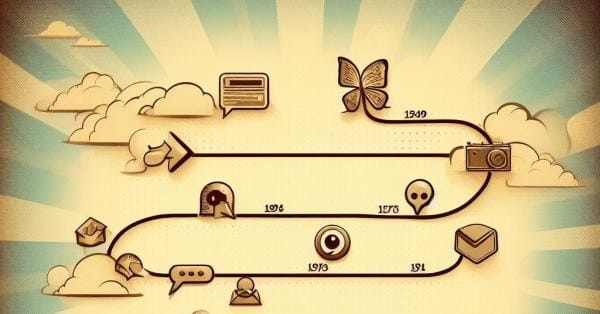A Quirky Journey Through the History of Online Chat Rooms
Long before the internet, people were already gagging for instant messaging they just didn’t have the thumbs for it yet. The Victorians had the telegraph, which was basically Tinder for people who owned monocles. You’d send a message like: “Dearest Margaret STOP I admire your ankle STOP Let’s meet behind the butchers STOP” – very saucy stuff.
Before Discord servers and dodgy Omegle calls, chat meant something raw, weird, and kind of magical. No emojis. No filters. Just a blinking cursor and some stranger asking “ASL?”
In 1973, developers on the PLATO system created Talkomatic, the first multi-user chat room, which could host a whopping five people per room. It was simple and text-based, yet groundbreaking – no images, no emojis, just orange text on a black screen scrolling as people typed.
I used to be chatting online and someone rang the house phone and you would be instantly disconnected from the internet, hilarious when I think about It now, as well as costing you 5 pence per min to be online.
It’s hard to believe, but at one point, having five strangers awkwardly typing “hi” to each other in real-time was revolutionary.
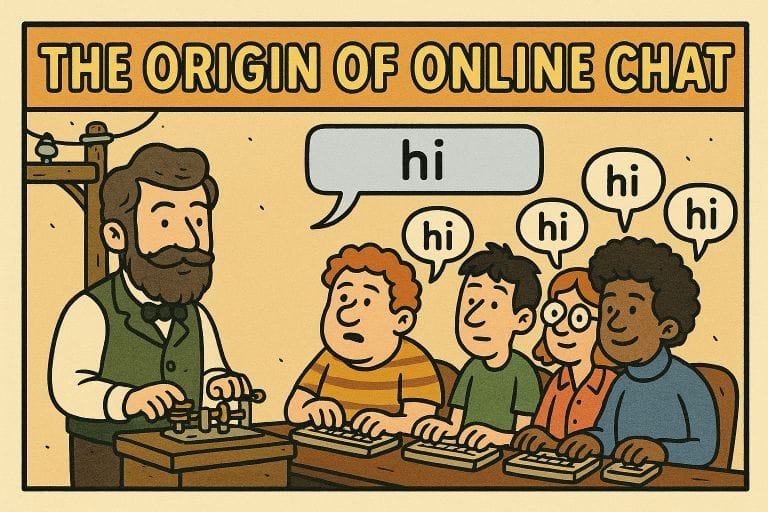
Right, I could go into all the techy details – baud rates, modems that sounded like R2-D2 having a panic attack – but the truth is, I started in chat rooms in the late 80s. Back then, in the UK, being online was about as common as having a fondue set that actually worked. It was basically just me, a couple of software engineers, and probably a bloke from Milton Keynes pretending to be a Swedish woman.
You needed a desktop computer the size of a washing machine. No mobiles, no tablets, not even a laptop unless you worked for NASA or Knight Rider. The internet came through the phone line, which meant that if your mom picked up the receiver, the whole thing collapsed like a soufflé in a stampede.
And it wasn’t “fast internet” either – it was so slow, if you typed “hello” in a chat room, by the time the other person got it, they’d moved house. Or died.
But I loved it. It was magical – chatting with complete strangers you’d never meet in real life, without any of the small talk or the awkward bit where they see your shoes and judge you. It felt pure, like the early days of CB radio, but with less trucker lingo. No registration, no emails – nobody said “drop me a DM” unless they were referring to Dire Straits’ back catalogue.
Then came Hotmail, and we all thought we were Bond villains with our first email addresses: mine was probably something like “chatlord87@hotmale.com” – accidentally very different vibe.
Now everything’s algorithms and engagement metrics. In the 80s, my engagement was typing “Hi everyone!” and waiting ten minutes for someone to say “asl?”
And when they did, you’d answer honestly: “34, M, West Midlands. You?” And they’d reply: “13, F, Antarctica. lol jk.”
Anyway, chat rooms were brilliant. And yes, they’ve changed – now it’s all Discord this and Telegram that. But I still miss the days when “LOL” actually meant you’d laughed. Not just breathed slightly heavier through your nose.
Webcams did not exist as far as I am aware, some computers did not even have a mic slot, and voice chat was impossible. Now, the possibilities or endless back then, the World Wide Web was not a phrase spoken ever.
The 1980s: CompuServe and BBSes
By the early 1980s, more people were coming online and looking for someone to chat with (besides ELIZA, the chatbot therapist). CompuServe – one of the first consumer online services – launched its CB Simulator in 1980, named after Citizen’s Band radio, to let users text-chat like truckers on the digital highway. Around the same time, hobbyists dialling into BBSes (Bulletin Board Systems) could leave public messages or even join primitive chat channels if the sysop was feeling generous. It was all delightfully clunky: slow modems, text-only screens, and the ever-present risk that your mom would pick up the home phone and ruin your connection mid-chat.
When I first went online, I was wondering what all the fuss was about. You could go to boring bulletin boards, newsgroups (even more boring), browse the net, less boring but very slow, 1 page every few minutes if you are lucky, then there are chat rooms, and the internet was suddenly more fun, you had to download the bulletin boards and then most of them were just crappy posts anyway.
However, it’s fair to say forums, message boards, and newsgroups were forerunners for communication. They were rubbish, I hated them, it was hard to post and comment, they were open to abuse, and you could quickly lose track of what was happening.
The Birth of Internet Relay Chat (IRC) and Nerdy Glory
In 1988, a Finnish computer science student decided that the internet needed its own chat system for real-time group talk. Thus was born Internet Relay Chat (IRC) – a platform so nerdy and text-centric that it made CompuServe look user-friendly. IRC lets anyone create or join channels on servers worldwide, spawning a vast network of chatrooms on every topic imaginable. Tech geeks, university students, and pretty much anyone with a modem and time to kill flocked to IRC. It even proved its worth when users on IRC relayed news about the 1991 Gulf War in real-time, effectively becoming the Twitter of the first Iraq war (albeit one where every username was something like DarkLord42 or JaneDoe1990).
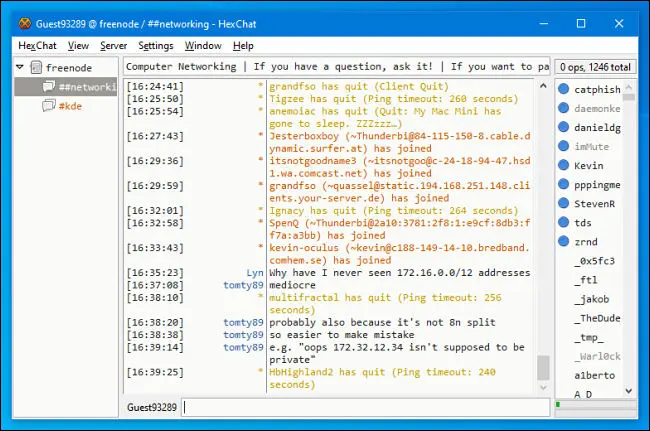
IRC was anarchic and fun: no avatars, no profiles, and an interface that looked like the Matrix if you squinted. Conversations were entirely in text, and if you wanted to express emotion, you had to do it with emoticons or acronyms. (FYI, the upside-down smiley face and saying “LOL” unironically both trace their lineage to these times.) IRC also introduced concepts like moderators (channel operators who could kick out troublemakers) and bots (automated participants) – early clues that managing online communities might be as hard as herding digital cats.
Despite the lack of graphics or any modern conveniences, IRC built a strong community spirit. Users from around the globe bonded over niche interests, whether it was coding, music trading, or debating the superior flavour of pie. And yes, the classic newbie question “ASL?” (Age, Sex, Location?) became the cheesy icebreaker of the era.
You can read more about this on my IRC chat in-depth page.
When Chat Rooms Got Weird: Vampires, Vimto, and Bots Gone Rogue
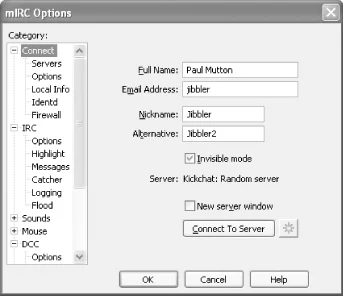
For all the normal chatrooms, there were plenty of oddball ones too. Niche communities flourished, sometimes with bizarre themes. On Yahoo Chat, for example, you could stumble into a “Vampire Chat” room late at night, where people earnestly role-played as vampires. Some participants even claimed to be real vampires (the kind who preferred blood over coffee). Trolls – ahem, mischievous users – would crash these rooms and quip, “Have you tried a nice glass of Vimto instead of blood?” which, predictably, did not amuse the self-proclaimed creatures of the night.
This era saw the birth of many such inside jokes and early trolling. Yet, it was largely innocent fun by today’s standards – a bunch of humans (and a few bots pretending to be humans) experimenting with online personas in real-time.
However, as chat rooms grew, troublemakers and spammers took notice too. Unmoderated rooms occasionally turned into the Wild West. One particularly notorious example was the chat service run by a UK ISP called Freeserve. Freeserve’s public chatrooms were hugely popular around 1999-2001, but they developed an uncontrollable bot infestation. Spam-bots (automated programs) would flood the rooms with ads and gibberish, and the admins simply couldn’t stop them. Regular users would often log in to find more robot “users” hawking dodgy websites than real people to talk to. Eventually, Freeserve’s chat was so overrun that it shut down – apparently, not even any screenshots of it survived for posterity. Consider it an early lesson that every online party can be crashed by party-crashers (or spambots).
The Rise of Instant Messengers and Global Chat Platforms
As chatrooms thrived, another form of online socialising was booming: Instant Messaging (IM). Rather than large public rooms, IM lets you chat one-on-one (or in small groups) with your approved buddies. In 1996, an Israeli company introduced ICQ (shorthand for “I Seek You”), which was basically the first globally popular IM platform. It had features we take for granted now – user profiles, searchable directories, and the ability to “ping” someone with a message that went “Uh-oh!” (that iconic ICQ message chime still haunts some of us). At its peak around 2001, ICQ had some 100 million users worldwide – not bad for an app that came on a floppy disk and connected over dial-up! AOL was so impressed (or scared) that they bought ICQ’s parent company in 1998 for a hefty sum.

Soon, every major tech company wanted in on IM. AOL launched AIM (AOL Instant Messenger) for everyone, not just AOL subscribers. Yahoo! Messenger and MSN Messenger followed in 1998 and 1999. Each had its quirks and devoted fanbase. AIM users will recall chatting with the clever (and sometimes sassy) chatbot SmarterChild. MSN Messenger fans mastered the art of the “nudge” – a feature that made the chat window shake violently, basically the digital equivalent of waving frantically to get someone’s attention. Yahoo Messenger integrated directly with Yahoo Chatrooms and introduced the buzz (a similar attention-grabber accompanied by a loud ding).
It was an era of friendly rivalry: you were either Team MSN or Team AIM or stubbornly clinging to ICQ’s flower icon, or running all three because you had that one friend who refused to leave ICQ. By the mid-2000s, third-party clients like Trillian emerged, letting power-users juggle multiple chat networks in one window (and feel like elite hackers while doing it).
Crucially, instant messengers started to connect people across the globe. For example, in China, a program called OICQ was launched in 1999 as a clear ICQ clone. After a trademark tussle (ICQ’s owner AOL wasn’t thrilled), it rebranded simply to Tencent QQ – and promptly exploded in popularity. QQ added fun features like avatars, custom emojis, and even casual games, becoming far more than just a chat app. With China’s vast population coming online, QQ’s user count skyrocketed. By 2023, QQ boasted roughly 597 million monthly active accounts – nearly twice the population of the United States chatting, shopping, and gaming on one platform.
Meanwhile, Poland had its own star messenger: Gadu-Gadu (meaning “chatter” in Polish), launched in 2000. Gadu-Gadu became so ubiquitous in Poland that by its 10th anniversary in 2010 it had over 10 million active users – pretty impressive in a country of ~38 million people. Users there traded GG numbers the way others might trade phone numbers, and the app eventually added features like VoIP calls and games.
Other regions had their favourite, too. In Japan, text messaging on phones (via SMS and later apps like Mixi or LINE) took off, while in much of Latin America and Europe MSN Messenger reigned supreme. It was fascinating: the world was getting connected through these various chat platforms, yet we were fragmented by which service we chose. (This is why some of us had an embarrassingly long email signature listing all our chat handles: AIM, MSN, Yahoo, ICQ, Jabber… just in case!). Even niche communities had their own preferred chat hangouts – gamers, for instance, often congregated on IRC or XMPP servers, or used game-specific chats (anyone remember the Battle.net chat lobbies in StarCraft?)
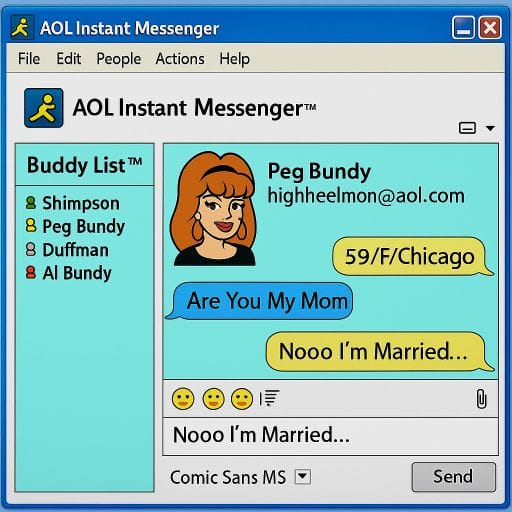
Chat room History Landmarks.
- The first chat room was created in 1973 by a man named Doug Brown.
- The chatroom was called “Talkomatic” and was used by Brown and his friends to communicate while playing the game “Zork”.
- In 1980, another chat room called “PLATO Notes” was created.
- This chat site was used by students at the University of Illinois to communicate with each other.
- In 1986, the first online chat service called “CompuServe CB Simulator” was created.
- This chat service allowed users to chat with each other in real time.
- In 1988, the first web-based chat service called “IRC” was created.
- In 1997, the first chat service specifically for teenagers was created, called “AOL Instant Messenger”.
- In 1999, the first chat service specifically for adults was created, called “AdultFriendFinder”.
- As of 2017, there are an estimated 3.5 million virtual chat rooms in existence.
The Golden Age: AOL, MSN and the Race to Rule Chat
The mid-to-late 90s were truly the Golden Age of chatrooms. As the World Wide Web took off, millions of ordinary folks discovered the thrill of jumping into a virtual room full of random strangers and striking up conversations (sometimes meaningful, often utterly nonsensical).
Companies quickly realised that chatrooms were actually a fantastic way to drive traffic to their websites, so they started creating their own applications and instant messaging software. I was there to experience this era firsthand, and let me tell you – it was something special.
America Online (AOL) was one of the first to truly grasp the power of chatrooms. Remember, this was the dial-up internet era (ask your parents), and AOL was absolutely massive – think Microsoft today, but with a twist: when you used AOL, you had to use their browser. You couldn’t close it. Sure, you could open another browser, but that AOL window had to stay open.
This worked brilliantly for them because AOL had chatrooms built right into their browser. You’d log in (greeted by that iconic “You’ve got mail!”), Then dive into chatrooms with names like “TV Shows – Seinfeld Fans” or “Singles Over 30”. The numbers were staggering: AOL had about 18,000 users online in chat rooms simultaneously and was logging a million user-hours of chat time per day. Think of it as the original social network – just with fewer profile pics and way more colourful screen names.
Not to be outdone, Microsoft jumped in with MSN Chat. They made entering their chatrooms ridiculously easy – just a simple download via Internet Explorer, and boom, you were in. And honestly? Microsoft chat was the best chatroom experience ever. They had the most engaging rooms and literally thousands of chatters – more than you could imagine.
Discover hundreds of chat room icebreakers and conversation ideas created by the World of Chat community to make every chat more relaxed and engaging.
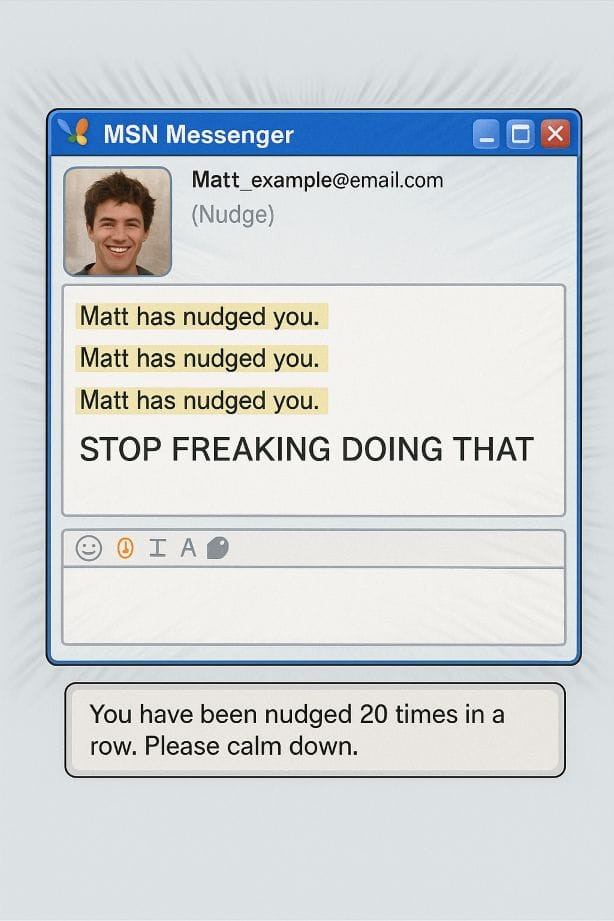
Yahoo! Chat also threw their hat in the ring, accessible via browser or its messenger. Remember, Yahoo was the biggest search engine and internet company at the time, operating in 28 countries with a massive global network. Interestingly, remnants of this era still exist today – you can visit Buzzen chat, which runs the very same software Microsoft used. It looks dated now, but it’s fascinating how it survived.
These big three (AOL, MSN, Yahoo) turned chatrooms into a genuine cultural phenomenon. After school or work, people would flock to rooms like Teen Chat, Music Lovers, or the infamous ASL Paradise to socialise. It felt excitingly anonymous yet communal: you were just a username among strangers, free to be as cool, weird, or flirtatious as you dared (within terms of service, of course).
At the time, there were millions of people online all over the world, all chatting away in these virtual spaces. It’s bittersweet to think that all of these platforms are now either closed or shadows of their former selves. AOL no longer exists as we knew it, Yahoo lost massive ground to Google, and Microsoft also fell behind Google’s dominance. Microsoft’s acquisition of Skype – with its not-very-cool interface – was arguably one of their biggest mistakes, having a brief window of success before more or less disappearing by 2022.
You can find out more about these services here and gives more information about what happened to chatrooms like MSN Yahoo, etc
Beyond Text: Graphical Chat Worlds and Avatars
While most of us were fine with plain text and the occasional emoticon, some visionaries in the 90s said, “Why not make chat more visual – maybe even 3D?” This led to some wonderfully experimental (and now obscure) chat platforms that were ahead of their time.
One example was The Palace, launched in 1995, which let users gather in virtual rooms decorated with graphics and use customizable avatars (basically small cartoon characters) to represent themselves. You could even wear props and outfits – the closest thing to modern avatars back then. The Palace was like a primitive metaverse meeting an AOL chatroom: you’d enter a castle or a space station (as a smiley face, perhaps, or any image you chose) and chat via speech bubbles that appeared over your avatar’s head. It was funky and beloved by its community, though it remained niche. People spent hours there designing pixel-art outfits and probably inventing the first dance emoticons by rapidly toggling avatar images.
In the same era, Active Worlds launched in 1995 as one of the first 3D chat environments. It allowed users to explore shared virtual worlds in three dimensions, kind of like a rudimentary Second Life (which it actually predated by almost a decade). Active Worlds even let users build structures in the virtual environment and had basic voice chat and IM features built in. The graphics were blocky, the download was huge (for dial-up), and it ran at a snail’s pace on most 90s PCs – but it was undeniably cool to walk around a virtual town and bump into other avatars for a chat.
Similarly, there was Worlds Chat (by Worlds Inc.) around 1995, which featured a 3D space station where people floated around as bizarre astronaut avatars and talked to each other. These graphical chat worlds gained cult followings and even saw events like virtual weddings (yes, the first online wedding reportedly happened in one of these 3D worlds in the 90s!). They set the stage for later phenomena like Habbo Hotel in 2000 (a cartoony 2D hotel world popular with teens – until trolls in afro hairdos invaded the virtual pool en masse) and eventually Second Life in 2003, which took virtual world chatting to new heights.
Alas, for all their innovation, the graphical chat worlds were too ahead of the curve. Most 90s internet users were busy trying to keep their connection from dropping, and here were these heavyweight programs demanding high bandwidth and patience. They remained on the fringes while text-based chat continued to dominate. Still, they deserve a nod for introducing concepts of online identity and digital gatherings that are commonplace today (hello, metaverse concerts and Fortnite hangouts).
The Chatroom “Death” and Rebirth
By the late 2000s, something changed. Traditional moderated chatrooms (like those old AOL/Yahoo rooms) started to decline. Social networking sites and forums took over the function of meeting people online. Why sit in a random chatroom hoping someone cool pops in, when you could curate a friends list on MySpace or Facebook and message people directly? One by one, the big portals shut down their chatroom services – often citing safety issues. Microsoft closed MSN Chat in 2003, and Yahoo finally shuttered its public chatrooms in 2012. The era of “Everyone is welcome, let’s talk about anything, no real names required” seemed to be ending. Chatrooms were increasingly seen as havens for spambots, creeps, or just old ghost towns with a dozen idle users and a tumbleweed bot saying, “Anyone here?”
But as with many things online, chat didn’t really die – it just evolved. Interestingly, the classic chatroom concept saw a strange rebirth in the late 2000s with a twist: anonymity and randomness. Enter Chatroulette and Omegle around 2009. These services paired you with a complete stranger for a one-on-one chat – sometimes just text, but often via webcam. It was the digital equivalent of talking to random people on the street… if the street was dark and everyone wore masks 🙃.
Initially it was novel and exciting (Who will I meet? A Norwegian grandma? A student in Brazil?). However, the lack of oversight meant things went south quickly. Omegle, for example, had no age restrictions at launch and no filters, so you can imagine how quickly it filled up with, uh, questionable content. Before long, both Chatroulette and Omegle became infamous for users (usually male) exposing themselves on camera, and a barrage of sexual content. Omegle did eventually try to implement a “minimal” profanity filter, but it was much too little, too late. After numerous horror stories and even a major lawsuit over child safety issues, Omegle shut down in 2023, its legacy forever marred by what one might call a “parade of unsolicited nudity“. Chatroulette also faded into obscurity as a punchline on late-night TV rather than a serious platform.
Yet, the idea of connecting with strangers hasn’t vanished – it just moved to new forms (from Reddit communities to apps like YikYak or the myriad chat features in modern games). And interestingly, some old-style chat forums have survived in pockets. Certain independent chat websites soldiered on, often unmoderated and wild. (Just peek at something like Chat Avenue today and you’ll feel like you time-travelled to 2005 – it’s busy, chaotic, and probably not a place you’d take your kids without a hazmat suit). These places remind us that as long as the internet exists, there will always be some corner where people are up at 3 AM typing strange things to strangers.
The last big chat room was Yahoo chat, which closed its doors 10 years ago in 2012, which more or less made people who enjoyed chat stop, as new chat rooms did not have many users, thus less chance of meeting new people.
It is difficult to understand now how big MSN chat, Yahoo chat and even Lycos were back in the day; these were all powerhouses of the chat world.
The rise and fall of chat
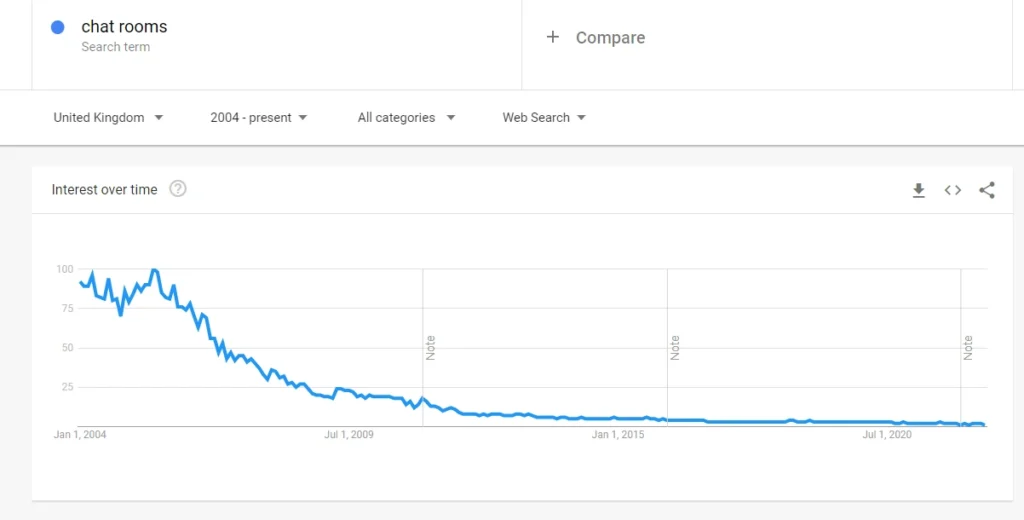
Modern Messaging: Chats Eat the World
If traditional chatrooms were the Wild West saloons of the internet, modern messaging apps are like the Starbucks on every corner – ubiquitous, convenient, and part of daily life. The 2010s saw the absolute domination of services like WhatsApp, Facebook Messenger, WeChat, and Telegram. By 2016, over a third of the world’s population was using some kind of messaging app regularly. WhatsApp, launched in 2009 as a simple mobile messenger, grew to billions of users and by 2025 was handling over 2 billion users monthly. Facebook Messenger likewise crossed the billion-user mark in the mid-2010s.
In China, WeChat took the concept of chat to a whole new level – not only could you message and group chat, but you could hail a taxi, pay your rent, book a doctor’s appointment, and likely play Pokémon all in one app. Essentially, what started as “hey let’s talk via text” evolved into the hub of all social and practical life online.
Interestingly, while personal chatting moved to phones and became more private (no more big public chat lobbies), the spirit of chatrooms found new life in work and gaming. Office communication shifted from long email chains to snappy real-time chat groups. Tools like Slack (launched 2013) literally market themselves as replacing the office watercooler. Now employees could send each other GIFs and emojis about the latest client request – truly, the professional dream.
And for gamers and hobby communities, Discord (launched 2015) resurrected the idea of themed chat channels and communities, but with modern bells and whistles (voice chat, integrations, etc.). Discord is basically IRC on steroids with a nice UI – you join a server (equivalent to an old chatroom or forum) dedicated to a topic or game, and there are multiple text and voice channels inside. It caught on like wildfire beyond gaming, and today there are Discord servers for everything from study groups to gardening clubs.
We’ve kind of come full circle: we’re back to hanging out in chatrooms, but now we call them servers or group chats, and they often require an invite link. The vibe, however, of jumping into a conversation with a bunch of people who share an interest – that’s the same buzz we got from AOL rooms in 1998, just with better memes.
It’s not gone, it has just evolved.
So chat isn’t dead. It just grew up, got a new haircut, and started calling itself something else. But under all the apps and memes and notifications, the heart of chat is still the same strangers, conversations, and that weird little thrill of typing something into the void and getting a reply
I still remember logging into Microsoft Chat, excited to see who was around. When the rooms were full of people from all over the World, dialling in with my modem, excited to see who was online, I was there till 3 am, talking to random American people about TV and movies, those days are sadly gone now.
They are mostly called social networking or social media websites now.
There have been many casualties over the years,
Oh, and there is always World of chat, of course.
Long live the chat room!

